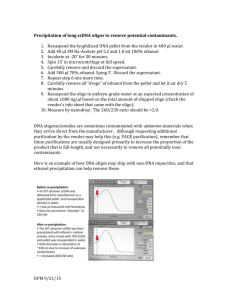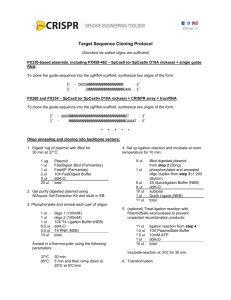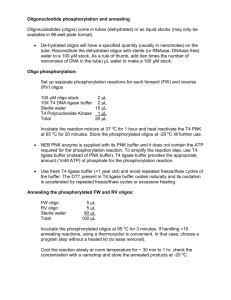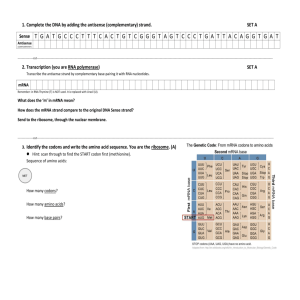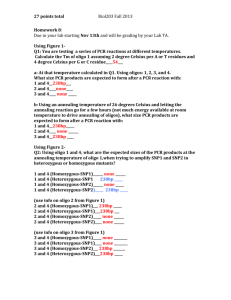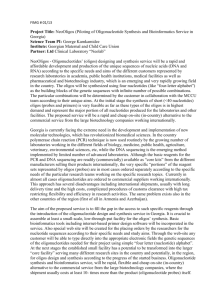Synthesis, Purification, and Cell Culture Experiments with Anti
advertisement
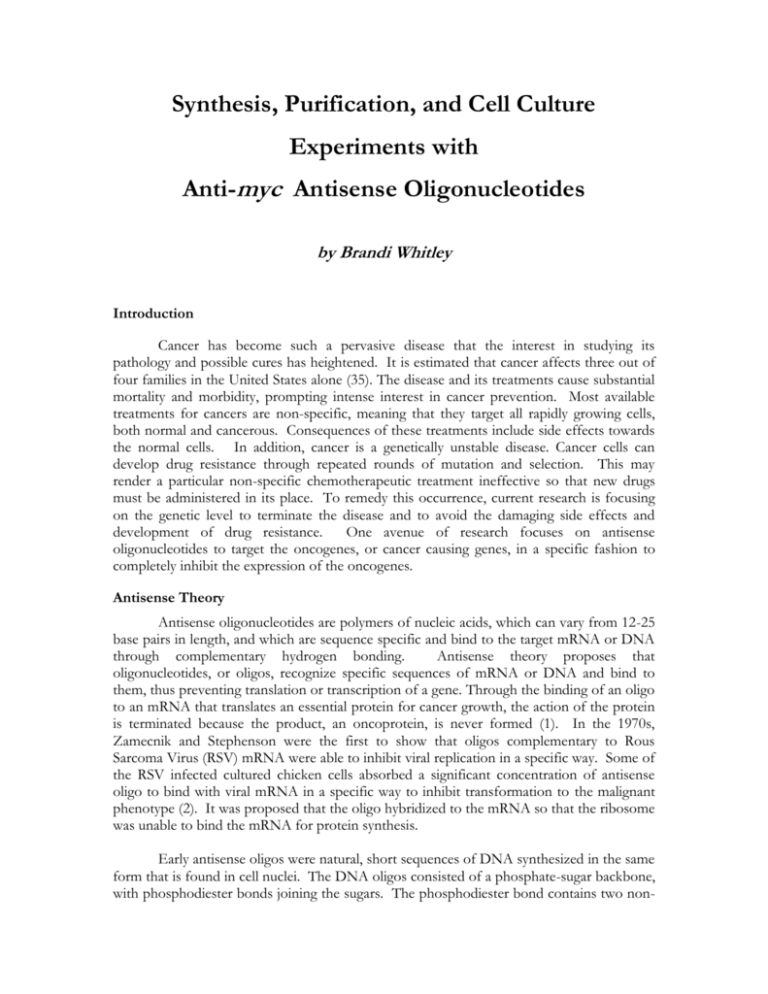
Synthesis, Purification, and Cell Culture Experiments with Anti-myc Antisense Oligonucleotides by Brandi Whitley Introduction Cancer has become such a pervasive disease that the interest in studying its pathology and possible cures has heightened. It is estimated that cancer affects three out of four families in the United States alone (35). The disease and its treatments cause substantial mortality and morbidity, prompting intense interest in cancer prevention. Most available treatments for cancers are non-specific, meaning that they target all rapidly growing cells, both normal and cancerous. Consequences of these treatments include side effects towards the normal cells. In addition, cancer is a genetically unstable disease. Cancer cells can develop drug resistance through repeated rounds of mutation and selection. This may render a particular non-specific chemotherapeutic treatment ineffective so that new drugs must be administered in its place. To remedy this occurrence, current research is focusing on the genetic level to terminate the disease and to avoid the damaging side effects and development of drug resistance. One avenue of research focuses on antisense oligonucleotides to target the oncogenes, or cancer causing genes, in a specific fashion to completely inhibit the expression of the oncogenes. Antisense Theory Antisense oligonucleotides are polymers of nucleic acids, which can vary from 12-25 base pairs in length, and which are sequence specific and bind to the target mRNA or DNA through complementary hydrogen bonding. Antisense theory proposes that oligonucleotides, or oligos, recognize specific sequences of mRNA or DNA and bind to them, thus preventing translation or transcription of a gene. Through the binding of an oligo to an mRNA that translates an essential protein for cancer growth, the action of the protein is terminated because the product, an oncoprotein, is never formed (1). In the 1970s, Zamecnik and Stephenson were the first to show that oligos complementary to Rous Sarcoma Virus (RSV) mRNA were able to inhibit viral replication in a specific way. Some of the RSV infected cultured chicken cells absorbed a significant concentration of antisense oligo to bind with viral mRNA in a specific way to inhibit transformation to the malignant phenotype (2). It was proposed that the oligo hybridized to the mRNA so that the ribosome was unable to bind the mRNA for protein synthesis. Early antisense oligos were natural, short sequences of DNA synthesized in the same form that is found in cell nuclei. The DNA oligos consisted of a phosphate-sugar backbone, with phosphodiester bonds joining the sugars. The phosphodiester bond contains two non- bridging oxygens, one of which contributes to the negative charge of the DNA molecule. No chemical modifications were made to these oligos; they are referred to as PO2s, or phosphodiesters (Figure 1). As such, the unmodified phosphodiester oligos were subject to nuclease degradation as any foreign DNA is in a cell, leaving only a short time for the oligos to bind to mRNA before being subject to cellular nucleases. '5 Base O Phosphodiester O P O O O Base O Monothiophosphate O S Figure 1. Modifications to the phosphatesugar backbone of the antisense DNA molecule, including the phosphodieste monothiophosphate, and dithiophosphate. - P O- O Base O Dithiophosphate O S S- P O 3' A solution to the nuclease digestion of PO2s was to modify one or more parts of the oligo structure. An oligo that is capable of antisense inhibition of gene expression must possess resistance to nuclease degradation, efficient uptake into the desired cells, an affinity for the targeted mRNA, specific recognition of the targeted mRNA, and a mechanism of inhibition (4). To achieve these requirements, several attempts at modifications have been made. Methylphosphonates, phosphotriesters, phosphoramidates, and monothiophosphates are examples of modifications of the phosphate-sugar backbone of antisense DNA (4) (Figure 2). X Z P O Y X Y Z Methylphosphonate O CH3 O Phosphotriester O OR O Phosphoramidate NH O- O Figure 2. Modifications to the sugar-phosphate backbone of DNA. The monothiophosphate modification is shown in Figure 1. Note: R is any organic group that is added. The most studied of these modifications, and one object of this research, are the monothiophosphates, or POS modifications (Figure 1). POS oligos are modified through the addition of one sulfur atom in the place of one non-bridging oxygen atom in the phosphodiester backbone. The POS modification has advantages and disadvantages. Sulfur exhibits properties similar to those of oxygen, thus it is an ideal substitution because it alters some properties of the unmodified oligos, such as susceptibility to nucleases, while maintaining structural integrity and biocompatibility. The sulfur modification supplies resistance to nuclease degradation, and it also activates RNase H (4). RNase H is an enzyme for which the mRNA/POS oligo complex serves as a substrate; the RNA is hydrolyzed by the RNase H and the POS oligo is released to hybridize to a new target mRNA molecule (4). Unwanted properties do exist for POS oligos, so they are not the ultimate choice for antisense treatments. The addition of one sulfur atom produces a chiral center around phosphorus, and thus diastereomers are formed. The diastereomers obtained synthetically have shown decreased hybridization efficiency to the oligonucleotide specified site compared to achiral molecules (18). Also, the POS oligonucleotide diastereomers offer different nuclease stability and variable stability in forming duplexes with RNA (18). It is unknown yet whether a particular diastereomer is more effective than another because of the varying properties that have been demonstrated. The number of diastereomers that can be formed equals 2n, where n is the number of phosphodiester bonds in the oligo. A 15 base sequence has 14 phosphodiester bonds, so there are 214, or 16,384, diastereomers that may result during synthesis. It would be nearly impossible to know which diastereomer is most effective, let alone separate the most effective one from the others. A more recent modification, and perhaps a more promising one, is the replacement of both non-bridging oxygens of the DNA backbone with sulfur atoms, to form dithiophosphates, or PS2s (Figure 1). Such a modification eliminates the chiral center of the POS but maintains the resistance to nuclease degradation and the activation of RNase H. Sulfur atoms should not be substituted for both non-bridging oxygen positions in the backbone of a PS2 at each base position, as in the modification of the studied POS (see Figure 11), because it causes instability due to decreased hybridization affinity (18). Ghosh showed that the melting temperature of a 17-mer all phosphorodithioate (doubly substituted at all positions) was 17C lower than the PO2 and 11C lower than the POS (18). This shows a decreased stability with increasing sulfur substitution, so that there is a 1 depression in melting temperature for each modified base (18). It has been proposed by Cummins and co-workers that the minimal amount of dithio modification that will allow for all of the beneficial effects of the antisense oligonucleotide should be used (19), thus preventing toxicity and instability as much as possible. In this research, the dithio modifications were minimized, so that there are a maximum of three positions of double sulfur substitution (Figure 11). In addition to the sulfur modifications being studied in this research, there are numerous other modifications to antisense oligonucleotides that are under scrutiny. Uniformly modified N3’ P5’ phosphoramidates have demonstrated a high binding specificity for RNA (31). They have also shown resistance to nuclease degradation, but there is no evidence of the direction of RNase H activity (19). This modification consists of a 3’ amino group substituted for a 3’ hydroxyl group in the 2’ deoxyribose ring of the DNA (Figure 3). '5 Base O Figure 3. Phosphoramidate NH O modification (31). O- P O 3' Skorski and co-workers used a 15-mer anti-myc phophoramidate oligonucleotide to show that it was almost ten times as potent in antisense sequence-specific activity as the anti-myc phosphorothioate (POS) oligo (31). The phosphoramidates possess different physicochemical properties, which may affect their uptake by cells compared to the endocytosis mechanism of uptake exhibited for phosphorothioates. This hypothesis is supported by the results that the phosphoramidates were found in higher intracellular concentration than the phosphorothioates (31). Most recently, “second generation” antisense oligonucleotides, such as mixedbackbone oligonucleotides, have shown improved antisense properties over POS oligonucleotides (20). The mixed-backbone oligos contained POS segments at the 3’ and 5’ ends and a modified oligodeoxynucleotide analog, such as a methylphosphonate (Figure 2), or oligoribonucleotide analog, for example a 2’-O-methyl group, in the internal region of the oligonucleotide (Figure 4). '5 Base O O S P O- O Base O 2'-O-methyl group O O P OCH 3 O- O O Base Figure 4. An example of a mixed-backbone oligonucleotide with an oligoribonucleotide analog, a 2’-O-methyl group, in the internal region and POS modifications on the 5’ and 3’ ends. The idea of this type of oligonucleotide modification was to reduce the polyanionic effect of the sulfur modification for POS and PS2, a result of the negative charge at every phosphorus atom in the backbone of the oligo. The polyanionic effect stimulates the immune system in a sequence non-specific nature (20). The modification attempts to increase RNA affinity and RNase H activity, which would cause RNase H to be more active at degrading the targeted mRNA. Results of this research showed that oligos with a central mixed backbone modification, described above as a methylphosphonate or a 2’-O-methyl group, and flanking POS segments were more stable, showed more RNase H activity, and had less impact on immune stimulation (20). Another mixed-backbone modification has been studied by Kandimalla and coworkers, that of a limited number of 2’-5’ ribonucleosides within a core of a 3’-5’ deoxyribonucleotide that still allows for sulfur modification of the non-bridging oxygens in the backbone (21). This modified oligo with a POS sulfur backbone bound target strands of DNA and RNA and showed greater stability against nucleases than its PO2 counterpart. It was also found that 2’-5’ linkages are more stable than 3’-5’ linkages (21). HL-60 Cells and the myc Oncogene The purpose of my junior honors research with the Biology Department of Sweet Briar College was to compare the effects of anti-myc PO2s and modified POSs on a human leukemia cell line; this year, the research was extended to include PS2 oligos. The sequence of the antisense oligo is 15 bases in length and is complementary to the myc oncogene, hence the name anti-myc. The c-myc gene sequence is given in Figure 11, along with the anti-myc sequences and their modifications as POS and PS2 as well as two scrambled control (POSC) sequences and modifications. Both antisense oligos and scrambled control oligos were studied in order to explore if the oligos did indeed act in a specific antisense mechanism. The scrambled control serves to determine whether the action of the oligo is sequence specific or non-specific; it has the same base composition as the antisense oligo, but the bases are randomly scrambled (5). There are two scrambled control sequences in the series of oligos studied. In order to accommodate for simpler modifications of the PS2 scrambled controls, the location of two bases was switched. A POS modification of the PS2 scrambled control was synthesized, so there were two POS scrambled controls to serve as further comparison of specific versus non-specific effects. c-myc 3’TTG CAA CTC CCC ATG 5’ Anti-myc PO2 5’AAC GTT GAG GGG CAT 3’ Anti-myc PO2C 5’CTG AAG GTG CAT GAG 3’ (scrambled control) Anti-myc POS 5’AxAxCx GxTxTx GxAxGx GxGxGx CxAxTx 3’ (x = POS modification) Anti-myc POSC 5’CxTxGx AxAxGx GxTxGx CxAxTx GxAxGx 3’ (scrambled control) Anti-myc POSC2 5’CxTxGx AxAxGx GxTxGx CxAxAx GxTxGx 3’ (scrambled control, same sequence as PS2 scrambled control) Anti-myc PS2-1 5’ AAC GTT GAyG GGG CAT 3’ (y = PS2 modification) Anti-myc PS2-2 5’ AAyC GTT GAG GGG CAyT 3’ Anti-myc PS2-3 5’ AAyC GTT GAyG GGG CAyT 3’ Anti-myc PS2C-1 5’ CTG AAG GTyG CAA GTG 3’ (PS2 scrambled control) Anti-myc PS2C-2 5’ CTyG AAG GTG CAA GTyG 3’ Anti-myc PS2C-3 5’ CTyG AAG GTyG CAA GTyG 3’ Figure 11. The c-myc gene sequence and the anti-myc antisense oligonucleotides, with their modifications indicated as PO2, POS, and PS2. The c-myc gene sequence was obtained from Reference (8) and (17). The scrambled control sequence (PO2C and POSC) differs in one codon from the sequence in Reference (5) because of the supply of amidites for synthesis. Note that the PS2 modifications for the anti-myc sequence and the scrambled control sequence are modified in the same locations – middle, end, and both end and middle – but the base that is modified is different. The POSC2 sequence changed the position of two bases to allow for simpler modification and was a result of reagent availability. HL-60 is a human promyelocytic leukemia cell line derived in 1977 from the peripheral blood leukocytes of a patient with acute promyelocytic leukemia (7). Leukemias arise in blood-forming cells of the bone marrow. It is typical for leukemias to fail in normal differentiation while retaining their ability to proliferate, thus continuing to reproduce indefinitely. Normal blood cells, in comparison, will differentiate into mature red blood cells (erythrocytes), lymphocytes, macrophages, and granulocytes (9). Once these cells have matured, cell growth serves maintenance purposes only. These cultured suspension cells exhibit aneuploidy, as they have only 44 chromosomes (7). HL-60 cells are arrested in the promyelocytic stage of myeloid development; they possess proliferative capacity but are unable to differentiate in the absence of inducing agents (8). HL-60 cells show high levels of c-myc RNA, amplified 8-30 fold compared to normal cells. The high expression of c-myc in the cells occurs in direct association with an activated N-ras gene and the deletion of the nuclear p53 tumor suppressor gene (8). The common cause of promyelocytic leukemias is the reciprocal translocation between chromosomes 15 and 17, however, HL-60 cells do not display such abnormalities in their chromosomes (10). Murray and co-workers suggest that an alteration independent of this translocation causes the amplification of c-myc in HL-60 cells (11). The myc oncogene is a cause of cancer development because it permits the overexpression of the cellular myc gene (c-myc), the proto-oncogene. The function of c-myc in normal cells is indicated by its gene product; c-myc, when activated in response to growth factor stimulation, produces a nuclear protein that is implicated in the control of normal cell division (9, 12). When c-myc is amplified, as it is in HL-60 cells (10), it overexpresses this growth regulating protein so that the cells continue proliferating even in the absence of growth stimulating factors. If the expression of c-myc can be inhibited, for example with antisense oligos, cell growth can be decreased. Holt, Redner, and Nienhuis showed levels of c-myc protein to decrease 50-80% in HL-60 cells upon treatment with antisense oligos (8). These researchers used PO2s, and noted that the oligos were able to enter the cells to form a 15 base pair double-stranded duplex with the c-myc RNA, which in turn inhibited cell growth through decreased c-myc expression and induction of cell differentiation (8). If the promyelocytic cells cease proliferation in the early stages of myeloid development and are induced to differentiate, the growth of those cells is thus regulated. Mechanism of Oligo Action Once the Lipofectin™ has efficiently delivered the oligonucleotide to the cell, the oligo is free to act to inhibit the expression of the oncogene. The mechanism of action within the cell is not known exactly, but there are four proposed mechanisms described here. It is possible that the contiguous tetraguanylate (4G) tract within the anti-myc sequence (Figure 11) forms a complex structure that inhibits cell proliferation in a non-specific fashion (27, 29). Another possibility is the antisense specific binding of the oligo to the major groove of DNA to form a triplex that competes with DNA binding proteins for transcription initiation (30). It is also likely that the oligo could bind to mRNA to stop the expression of protein by inhibiting ribosome-mRNA association; the oligo/mRNA complex also serves as a substrate for RNase H (26, 28). A contiguous tetraguanylate sequence within the anti-myc sequence is known to form a higher order structure, such as a tetraplex (27) (Figure 13). This structure may interfere with the base pairing of the oligo with the target mRNA, so the effects on cell growth could be a result of a non-antisense mechanism. It is possible that the oligo with four guanines binds to serum proteins in a structure-specific fashion, creating a protein-oligo interaction that decreases cell growth (37). However, it has been demonstrated that the tetraguanylate tract does not always exert a non-specific effect on cell growth; Basu and co-workers found that no tetraplex structure formed at 37C under physiologically relevant conditions (27). Furthermore, complex structure formation was not facilitated nor stabilized in the presence of serum. Several factors influence the formation of these higher order structures, including the presence of ions, the concentration of DNA and ions, the length of the guanine-rich segment, and the extent of complementarity within the sequence (27). H N N N N H N N N O O N H H N H H N H N O H N N N H O N N H N N N N H Figure 13. Theorized structure of a tetraplex in a contiguous tetraguanylate tract in DNA. The higher order structure may be parallel or anti-parallel and forms hydrogen bonds between each of the four guanine bases (35). Tetraplex structure can be formed by tetraguanylate sequences in oligos, but it is not highly likely in the concentrations of oligo supplied to cells nor in the cellular conditions to which the oligos are subject (27). Saijo and co-workers also propose a second mechanism of oligo action involving the contiguous four-guanosine sequence that is present in the anti-myc gene sequence (29). Growth inhibition of human lung cancer cells by anti-myc was antisense sequence nonspecific and depended on the tetraplex structure instead when the oligo was applied at high concentrations (10 M). The tetraplex structure also caused loss of cell adhesion and changes in cell morphology (29). Some results of this study led to the conclusion that an antisense effect may be exerted at lower concentrations of oligo (1 M), through the inhibition of c-myc protein expression. Specific inhibition was demonstrated when a scrambled control sequence containing a four-guanosine tract was compared to an antisense sequence that also contained a four-guanosine tract. The antisense sequence caused a greater decrease in c-myc expression than the scrambled control sequence (29). Therefore, the observed inhibition of cell growth may be a combination of sequence specific and sequence non-specific mechanisms. In addition to the action of the tetraguanylate tract, another non-specific mechanism has been demonstrated to contribute to the overall effect of oligos on cell growth. The polyanionic oligos may bind to proteins such as fibroblast growth factor and inhibit protein binding to cell surface receptors, thus inhibiting cell proliferation (29). A third antisense mechanism that has been proposed for oligonucleotide action explains that the short oligo binds in a sequence specific fashion to the double stranded DNA in its major groove (30). The intermolecular triplex that is formed inhibits transcription of c-myc because the initiation site is blocked from binding a site-specific DNA binding protein. Both reverse transcriptase and DNA polymerase are unable to carry out their function when the triplex-forming oligo has successfully bound itself in a sequence specific manner to the major groove of the duplex DNA. The inhibition of transcription of c-myc would lead to a decline in cell growth because the oncogenic protein is never formed. Holt, Redner, and Nienhuis conceived of a fourth antisense mechanism for anti-myc in which the oligo forms a duplex with its complementary mRNA (8). The duplex caused inhibition of c-myc expression and subsequent growth inhibition and cell differentiation. When the oligo binds to the mRNA to form the duplex, the ribosome is unable to bind and therefore protein synthesis is inhibited (4). In addition, the mRNA/oligo complex serves as a substrate to activate the enzyme RNase H (4). Thus, RNase H cleaves the RNA strand, releasing the oligo in the process to allow further binding to more mRNA. Despite the lack of a definite mechanism for oligonucleotide action, research has shown that cancer cell proliferation can be inhibited through the addition of antisense oligonucleotides. Whether the mechanism is sequence specific, sequence non-specific, or a combination of both, oligos have proven to be effective. Modifications of oligos are now a focus in research, to develop an antisense oligo that can carry out the desired action, inhibiting the growth of cancer cells, with the least amount of difficulty, such as nuclease degradation or diastereomer formation. Phosphorodithioate antisense oligonucleotides are a possible solution for cancer treatment because they overcome several problems of monothiophosphate oligos and they have shown in a few early studies that they are effective in inhibiting cell growth (18, 19, 28). Thus, in this research the possibility of antisense activity was explored using PS2 antisense oligonucleotides. The oligos were applied in cell culture studies to HL-60 cells to determine their effect on cell growth compared to POS and PO2 oligos. Conclusions Researchers such as Zamecnik and Stephenson and Holt, Redner, and Nienhuis used unmodified oligos to target oncogenes and were successful in their endeavors (3, 7). The PO2 anti-myc sequence used in this research showed no antisense action against c-myc in the HL-60 cells, as determined through cell counting. The difference in results may arise from the fact that the experiments were carried out differently, and a decade apart from one another. More importantly, the experiments were carried out with different cell types and different assay procedures. Holt, Redner, and Nienhuis incubated the unmodified oligos in the growth medium with the HL-60 cells in 1988 and allowed for random uptake by the cells. They recognized the half-life of the unmodified oligos, but still obtained decreased cmyc protein expression. Their studies focused on the first few hours after incubation for detecting oligo action (7). In 1998-99, this research used modified antisense oligos in addition to the unmodified oligos to study effects on HL-60 cells. Lipofectin was used as a means of introducing the antisense oligos into the cells, rather than just allowing for random uptake of the oligos. Thus, the cellular concentrations of antisense oligos probably differed between these experiments and those of Holt, Redner, and Nienhuis. Two factors may contribute to the differences in the experimental results. The experiments described here lasted for 96 to 120 hours, with measurements of cell growth taken every 24 hours by means of cell counting. Holt, Redner, and Nienhuis studied the cells just 4 hours after transfection and incubation and determined oligo action by measuring protein expression. This research focused on the long-term stability of the antisense oligonucleotides in the inhibition of HL60 cell growth. In investigating the effects of anti-myc on cell growth in this research, cell counting was the only means of determining whether cells grew or not. It is possible that other assays could be used to study HL-60 proliferation. Holt, Redner, and Nienhuis suggest that HL-60 cells are induced to differentiate when c-myc expression is decreased. A test for differentiation, such as expression of a protein or antibody, could be developed to study the effects of anti-myc oligos. These researchers also note that differentiated HL-60 cells do not grow rapidly like the HL-60 cells that overexpress c-myc (7); this could be the cause of the decrease in cell counts after addition of the antisense oligos. Soft agar assays are possible with HL-60 cells because proliferating HL-60 cells will grow in semi-solid media (5). If c-myc expression is decreased by anti-myc oligo action, the cells will not be able to grow in the soft agar. This assay will not give the quantitative results of cell counting; it also takes a long time to achieve results because the cells have to grow several days in the agar. Further research with modified antisense oligonucleotides was imperative after the spring of 1998 studies that were performed with only PO2 and POS oligos. Studies during the fall of 1998 and spring of 1999 were done with the dithiophosphate oligos to determine their effects on HL-60 growth in comparison to the demonstrated effects of PO2 and POS anti-myc oligos. The POS oligo was shown to demonstrate some type of antisense activity in the preliminary experiments, and once PS2 oligos and their scrambled control sequences were synthesized and purified, conclusive experiments could be carried out. Indeed, the PS2 oligos showed an inhibition of HL-60 cell growth as hypothesized, decreasing the growth of cells up to as much as 53%. Each modification of the PS2 oligo (middle, end, and middle and end together) affected cell growth in approximately the same way; there may have been some nuclease degradation of the PS2-1 sequence, but its effects on cell growth did not differ much from that of the PS2-2 and PS2-3. These experimental results seem to support the antisense theory model. If an antisense oligonucleotide does indeed act in a sequence specific, antisense manner to target a gene that is overexpressed in cancer or leukemia cells, gene expression can be inhibited and cell growth can be terminated. The application of this theory offers the potential to halt the growth of cancer cells if the overexpressed gene can be targeted in vivo. The hopes for the future include studying other cell types for similar effects by targeting different overexpressed genes using different antisense oligonucleotides. The difficulties in this research arise not in the cell culture aspect but in the synthesis and purification procedures for the oligonucleotides. The yields of the oligos are significantly low, all below 10% of the theoretical 0.2 mol synthesis yield. When an oligo is removed from the cartridge it was synthesized on, the theoretical yield is 0.2 mol. There are several steps that the oligo undergoes before it is finally prepared for addition to cell cultures. This gives much opportunity for loss of the oligo, whether due to small amounts remaining in a tube or in a pipette tip, or due to experimental error during the procedures. Lyophilization of the oligo may be where much of an oligo is lost. After lyophilization is complete, the oligo is resuspended in a very small amount of ultrapure water. The oligo is dried to the sides of a siliconized flask, so it is difficult to know when all the oligo has been dissolved. It is highly likely that much of the freeze-dried oligo remains in the flask. In order to determine where in the procedures the oligo is lost the most, a study of UV/Vis spectrophotometry measurements after each step is necessary. This may help to improve the final yields if a certain step is targeted as to where the product is lost. Higher yields of the antisense oligonucleotides would contribute to a more feasible application in in vivo studies. References 1. Rawls, R.L. Optimistic About Antisense. Chemical and Engineering News. 75, 35-39 (1997). 2. Zamecnik, P.C., Stephenson, M.L. Inhibition of Rous sarcoma virus replication and cell transformation by a specific oligodeoxynucleotide. Proceedings of the National Academy of Sciences of the United States of America. 75, 280-284 (1978). 3. Weintraub, H.M. Antisense RNA and DNA. Scientific American. 262, 40-46 (1990). 4. Lonnberg, H., Vuorio, E. Towards Genomic Drug Therapy with Antisense Oligonucleotides. Annual Medical Review. 28, 511-522 (1996). 5. Heikkila, R., Schwab, G., Wickstrom, E., Loke, S.L., Pluznik, D.H., Watt, R., Neckers, L.M. A c-myc antisense oligodeoxynucleotide inhibits entry into S phase but not progress from G0 to G1. Nature. 328, 445-449 (1987). 6. American Type Culture Collection Product Sheet. Rockville, Maryland. 7. Collins, S.J., Gallo, R.C., Gallagher, R.E. Continuous growth and differentiation of human myeloid leukaemic cells in suspension culture. Nature. 270, 347-349 (1977). 8. Holt, J.T., Redner, R.L., Neinhuis, A.W. Oligomer complimentary to c-myc mRNA inhibits proliferation of HL-60 promyelocytic cells and induces differentiation. Molecular and Cellular Biology. 8, 963-973 (1988). 9. Cooper, G.M. Elements of Human Cancer. Jones and Bartlett Publishers, Boston (1992). 10. Dalla Favera, R., Wong-Staal, F., Gallo, R.C. onc gene amplification in promyelocytic leukemia cell line HL-60 and primary leukaemic cells of the same patient. Nature. 299, 61-63 (1982). 11. Murray, M.J., Cunningham, J.M., Parada, L.F., Dautry, F., Lebowitz, P., Weinberg, R.A. The HL-60 transforming sequence: A ras oncogene coexisting with altered myc genes in hematopoietic tumors. Cell. 33, 749-757 (1983). 12. Bentley, D.L., Groudine, M. A block to elongation is largely responsible for decreased transcription of c-myc in differentiated HL-60 cells. Nature. 321, 702-706 (1986). 13. Flegner, P.L., Gadek, T.R., Holm, M., Roman, R., Chan, H.W., Wenz, M., Northrop, J.P., Ringold, G.M., Danielsen, M. Lipofectin: A highly efficient, lipid-mediated DNAtransfection procedure. Proceedings of the National Academy of Sciences of the United States of America. 84, 7413-7417 (1987). 14. Maurer, R.A. Cationic liposome-mediated transfection of primary cultures of rat pituitary cells. Focus. 11:2, 25-27. 15. Life Technologies Literature and Procedures for Lipofectin Reagent 16. Bennett, C.F., Chiang, M.Y., Chan, H., Shoemaker, J.E., Mirabelli, C.K. Cationic lipids enhance cellular uptake and activity of phosphorothioate antisense oligonucleotides. Molecular Pharmacology. 41, 1023-1033 (1992). 17. The National Center for Biotechnology Information, Entrez Database Nucleotide Query. (www.ncbi.nlm.nih.gov/Entrez/nucleotide.html) 18. Ghosh, M.K., Ghosh, K., Dahl, O., Cohen, J.S. Evaluation of some properties of a phosphorodithioate oligodeoxyribonucleotide for antisense application. Nucleic Acids Research. 21, 5761-5766 (1993). 19. Cummins, L., Graff, D., Beaton, G., Marshall, W.S., Caruthers, M.H. Biochemical and physicochemical properties of phosphorodithioate DNA. Biochemistry. 35, 8734-8741 (1996). 20. Agrawal, S., Jiang, Z., Zhao, Q., Shaw, D., Cai, Q., Roskey, A., Channavajjala, L., Saxinger, C., Zhang, R. Mixed-backbone oligonucleotides as second generation antisense oligonucleotides: In vitro and in vivo studies. Proceedings of the National Academy of Sciences of the United States of America. 94, 2620-2625 (1997). 21. Kandimalla, E.R., Manning, A., Zhao, Q., Shaw, D., Byrn, R.A., Sasisekharan, V., Agrawal, S. Mixed backbone antisense oligonucleotides: design, biochemical and biological properties of oligonucleotides containing 2’-5’-ribo- and 3’-5’deoxyribonucleotide segments. Nucleic Acids Research. 25, 370-378 (1997). 22. Gene Assembler Special/4 Primers User Manual. Pharmacia Biotech (1994). 23. Djordjevic, N.M., Houdiere, F., Fowler, P., Natt, F. HPLC separation of oligonucleotides in isocratic and temperature-programming mode. Analytical Chemistry. 70, 1921-1925 (1998). 24. Zelphati, O., Uyechi, L.S., Barron, L.G., Szoka, Jr., F.C. Effect of serum components on the physico-chemical properties of cationic lipid/oligonucleotide complexes and on their interactions with cells. Biochimica et Biophysica Acta. 1390, 119-133 (1998). 25. Meyer, O., Kirpotin, D., Hong, K., Sternberg, B., Park, J.W., Woodle, M.C., Papahadjopoulos, D. Cationic liposomes coated with polyethylene glycol as carriers for oligonucleotides. The Journal of Biological Chemistry. 273, 15621-15627 (1998). 26. Leonetti, C., D’Agnano, I., Lozupone, F., Valentini, A., Geiser, T., Zon, G., Calabretta, B., Citro, G., Zupi, G. Antitumor effect of c-myc antisense phosphorothioate oligodeoxynucleotides on human melanoma cells in vitro and in mice. Journal of the National Cancer Institute. 88, 419-429 (1996). 27. Basu, S., Wickstrom, E. Temperature and salt dependence of higher order structure formation by antisense c-myc and c-myb phosphorothioate oligodeoxynucleotides containing tetraguanylate tracts. Nucleic Acids Research. 25, 1327-1332 (1997). 28. Vaughn, J.P., Stekler, J., Demirdji, S., Mills, J.K., Caruthers, M.H., Iglehart, J.D., Marks, J.R. Inhibition of erbB-2 tyrosine kinase receptor in breast cancer cells by phosphoromonothioate and phosphorodithioate antisense oligonucleotides. Nucleic Acids Research. 24, 4558-4564 (1996). 29. Saijo, Y., Uchiyama, B., Abe, T., Satoh, K., Nukiwa, T. Contiguous four-guanosine sequence in c-myc antisense phosphorothioate oligonucleotides inhibits cell growth on human lung cancer cells: possible involvement of cell adhesion inhibition. Japanese Journal of Cancer Research. 88, 26-33 (1997). 30. Kim, H.G., Reddoch, J.F., Mayfield, C., Ebbinghaus, S., Vigneswaran, N., Thomas, S., Jones, D.E., Miller, D.M. Inhibition of transcription of the human c-myc protooncogene by intermolecular triplex. Biochemistry. 37, 2299-2304 (1998). 31. Skorski, T., Perrotti, D., Nieborowska-Skorska, M., Gryaznov, S., Calabretta, B. Antileukemia effect of c-myc N3’ P5’ phosphoroamidate antisense oligonucleotides in vivo. Proceedings of the National Academy of Sciences of the United States of America. 94, 39663971 (1997). 32. Iyer, R.P., Phillips, L.R., Egan, W., Regan, J.B., Beaucage, S.L. The automated synthesis of sulfur-containing oligodeoxyribonucleotides using 3H-1,2-benzodithiol 1,1-dioxide as a sulfur-transfer reagent. Journal of Organic Chemistry. 55, 4693-4699 (1990). 33. Weisler, W., Marshall, W., Caruthers, M. Methods in Molecular Biology, Volume 20: Protocols for Nucleotides and Analogs. 191-206. Ed. S. Agrawal. Humana Press, Inc.: New Jersey (1993). 34. Hamilton Precision Fluid Measuring Products Catalog, 118-121. 35. Oncolink website, Univeristy of Pennsylvania Cancer Center (www.oncolink.upenn.edu/specialty/med_onc/nature_cancer.html) (March 30, 1999). 36. Laughlan, G., Murchi, A., Norman, D.G., Moore, M.H., Moody, P., Lilley, D., Luisi, B. The high-resolution crystal structure of a parallel-stranded guanine tetraplex. Science. 265, 520-524 (1994). 37. Burgess, T.L., Fisher, E.F., Ross, S.L., Bready, J.V., Qian, Y., Bayewitch, L.A., Cohen, A.M., Herrera, C.J., Hu, S., Kramer, T.B., Lott, F.D., Martin, F.H., Pierce, G.F., Simonet, L., Farrell, C.L. The antiproliferative activity of c-myb and c-myc antisense oligonucleotides in smooth muscle cells is caused by; a nonantisense mechanism. Proceedings of the National Academy of Sciences of the United States of America. 92, 4051-4055 (1995).

